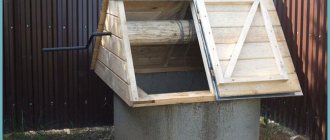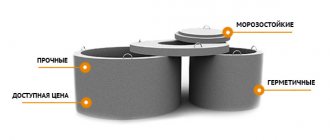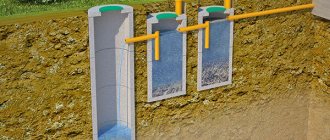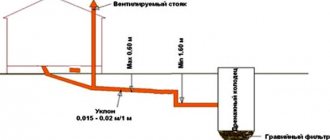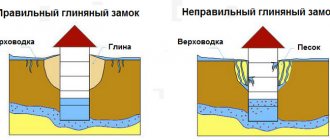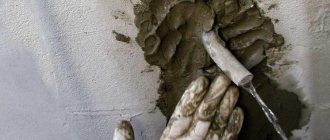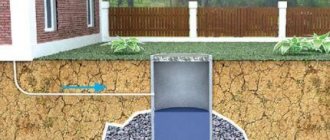Collection, purification and disposal of wastewater from the site is one of the most important tasks for ensuring comfortable living in a private country house. This article will describe the step-by-step process of constructing a sewer system from concrete rings with your own hands.
One of the most popular materials for solving this issue is concrete rings.
Devices made from such elements for a private home are the most durable, require virtually no repairs during operation, are financially affordable for any budget and are easy to install.
External waste disposal system
Sewer rings are the main component of its outer part, performing the functions of containers for various purposes in a wastewater treatment system. Products used are walk-through, without a bottom and equipped with bottoms. In addition, covers in the form of concrete slabs with a passage opening for maintenance are a mandatory element. For filter wells, rings with perforated walls are also used, in which a bottom filter is installed.
The finished container is equipped with two lids - an inner wooden one and an outer plastic or cast iron one. Concrete sewerage products are immersed in the ground to a depth that ensures that only the top cover protrudes outward.
The advantages of using such products include the following properties:
- strength, allowing you not to fear damage when the soil freezes in winter;
- durability - high-quality products of standard quality can serve in the sewerage system for up to 50 years;
- ease of installation - do-it-yourself reinforced concrete sewerage is quite affordable for most performers;
- cost savings on purchasing rings compared to ready-made plastic containers.
The main disadvantage of concrete sewer systems is the large volume of excavation work, but this property is equally inherent in any external drainage and wastewater treatment systems.
Laying the pipe and connecting it to the septic tank
The installation of an external sewerage pipe must be carried out taking into account certain technological features. The pit must be equipped at an angle towards the septic tank with a recess of 1 cm per 1 m of pipe. The septic tank must be installed so that the hole for installing the pipe is flush with the bottom of the connected trench. The correct location of containers should always be checked before installing communications. The tank is always placed in the ground only in a horizontal position.
After the location of the pipe is checked by level, special means of rigid fixation and waterproofing are used to allow the containers to move in the pit.
The connection method is always determined by the height of the external sewer pipe located near the house itself. It is recommended to equip the wiring in such a way that the hole in the foundation and at the point of insertion into the concrete septic tank are located only at one level.
If changing the point of wastewater discharge may be difficult, then the septic tank is mounted to a residential building with access to the surface. A pipe fragment located on the ground will have to be insulated with obligatory observance of the slope in those places where the bend is installed. This is necessary to prevent blockages from forming in the pipe.
How to calculate the volume of a container
For a more accurate calculation, we suggest using an online calculator.
In an effort to organize the most comfortable living conditions in a country house, the owners organize all the conditions inherent in urban conditions, including sewerage. In most cases, small suburban settlements are deprived of the opportunity to use centralized sewer networks due to their absence.
Therefore, each owner sets up local treatment facilities (LTP), designed not only to remove wastewater, but also to treat it to an accessible extent, ensuring safe living not only for his family, but for neighbors living nearby.
Watch the video
Do-it-yourself septic tank made of concrete rings. Sewage in the house
This event is quite expensive, and the larger the volume of wastewater that needs to be processed, the greater the cost of its construction. For this reason, calculating the required power when installing a sewer system with your own hands from concrete rings is a pressing task.
The most popular design solutions for a local sewer system are concrete rings or solid plastic containers. They are installed sequentially and consist of 2-4 sections that perform different tasks. The connection between them is made by pipes.
Functionally they operate as follows:
- The first container is called a storage tank and is designed to separate the mass of wastewater from solid and heavier components. They settle to the bottom of the vessel and are removed as they accumulate.
- The second tank is intended for biological treatment of wastewater. For this purpose, special cultures of bacteria are used, which are introduced into the vessel as needed. A sediment called activated sludge forms at its bottom, in which the bacterial composition is renewed. As necessary, this composition is pumped out, and a certain part of the mass is left for further use.
- In the third section, the wastewater is aerated by passing atomized air through it using a low-power compressor. Here the oxidation of wastewater occurs. Air also acts as a catalyst for the biological activity of the bacterial component.
- Further cleaning takes place in the filter well. To make it, concrete rings with perforated walls are used - in the lower part and an upper solid ring, covered with a concrete lid with an opening for passage inside.
A properly organized wastewater treatment system provides a degree of wastewater purification of up to 98%. This water can be safely used for watering the garden, washing cars and other household needs. Activated sludge is a very effective fertilizer.
The basic basis for calculating the volume of a sump is the average consumption value for one person, which is 200 liters of water per day.
Watch the video
DIY septic tank made from concrete rings from A to Z in one video
When calculating, this norm must be multiplied by the number of residents.
Table of container volume for a country house
| Number of residents | 2 — 3 | 3 — 4 | 5- 7 | 8- 9 |
| Useful volumes | 1,8 | 2,4 | 4 | 5,4 |
The table above is applicable for two or three chamber septic tanks.
It should be noted that for the first sections of the sewerage, concrete rings with a bottom are used to prevent untreated wastewater from entering the ground.
The data in the table is indicative only. The actual water consumption, and, consequently, the volume depends on the composition of the equipment used in everyday life. The presence of a sauna, jacuzzi, washing machine and dishwasher in the house significantly increases water consumption.
An example of calculating consumption volume
Let's assume that 4 people permanently live in the house. Then the approximate calculation of consumption volume will look like this:
- We determine the total liquid consumption per day - 4 x 0.2 = 0.8 cubic meters.
- Taking into account the standard for the minimum stay of wastewater in the settling tank for at least 3 days, we obtain the size of its capacity - 0.8 x 3 = 2.4 cubic meters.
- If you plan to use standard “15-9” rings, the internal diameter of which is 1.0 meters and the height is 0.7, we obtain the volume of the contents of one section 1.64 m. Thus, the total two-chamber capacity will be 3.28 cubic meters.
It should be taken into account that in reality the volume is somewhat lower, since the height should not be taken based on the size of the ring, but on the distance between the bottom and the edge of the overflow hole. But this will only be determined when drawing up an external sewerage project, and then the calculation will need to be checked based on actual dimensions.
Watch the video
The data obtained indicate that there is a certain reserve of external sewage capacity, but it will come in handy if you have to receive guests.
Overflow
If you are in the middle zone, lay pipes no deeper than 1.1-1.2 meters. The slope of the pipes through which the drains will flow should be 2 cm per linear meter. The inlet pipes must be located above the outlet pipes; water is directed down through special sewer tees, which are installed vertically (see photo).
Their lower ends collect water at depth, and their upper ends clear suspended matter.
In the pipes themselves, solids can be retained using special vertical pipes.
Do not forget to prepare holes for pipes in concrete rings in advance. Take care of openings for overflow pipes, as well as openings for the septic tank ventilation system.
Sewage device diagrams
The basic principle of manufacturing a wastewater tank from this material is to maintain a slope along the placement of individual sections. The slope is created by connecting intermediate elements - pipes; its value should be within 1-3 millimeters per meter of system length.
With a lower slope, solid components of the drain may be delayed. The same effect is observed with a greater slope - water drains faster than contaminants move. This creates a blockage in the pipe that needs to be removed using special means.
An important design element is the junction of the overflow pipes with the body of the concrete rings. It must be carefully sealed with cement mortar, preventing leakage. Otherwise, the sewerage system will not perform its functions.
The above diagram of a wastewater treatment device shows all the main design elements, the purpose of which will be described below.
Subtleties of purchasing material
When choosing a material for arranging wastewater communications, several points must be taken into account:
- reinforced concrete is characterized by high hygroscopicity. The surface of the tanks must be waterproofed;
- The concrete ring is heavy. Installation requires additional special equipment;
- low-quality material can easily crumble. Therefore, when choosing material for sewerage, it is better to choose trusted manufacturers.
All the disadvantages of sewer rings are easily corrected in the process of stage-by-stage arrangement. How to properly design and build drainage is the main question for owners of dachas and country houses.
Types of containers and features of their designs
Subject to the standard design of the device, design solutions may be different.
First of all, you need to understand that a septic tank is a source of increased danger to the environment and the uncontrolled construction of such facilities is prohibited. Before starting work, it is necessary to develop a project, approve it with the SES and only after that begin its construction. Permission can be obtained in full compliance with the requirements of San Pin and SNiP.
General rules for wastewater treatment facilities are as follows:
- The main document regulating the placement of sewage tanks in suburban areas is SNiP number 2.0403-85. It details the requirements for the location of the sewerage facility in relation to various buildings.
- If there are water supply facilities on the territory, the rules of relative location are provided for by SNiP 2.0401-85.
- Many distances according to the standards are provided for by the requirements of San Pin 2.1.5580-00.
- San Pin 2.2.1/2.1.1-12-03 establishes the rules for water protection zones of water supply facilities.
It should be taken into account that there are overlaps in the mass of regulatory documents. So in one of them the minimum distance from a shambo to a residential building is set at 10 meters, in others - 5. To avoid difficulties when approving a sewerage project, it is better to adhere to a larger norm.
Watch the video
➁SEPTIC TANK made from concrete rings WITH YOUR OWN HANDS ⓉⓊⓉⓈⓉⓇⓞⓘⓚⒶ
The design of a local treatment plant depends on many factors, ranging from the size and nature of the landscape to the qualitative composition of the soil. Therefore, there are several types of settling tanks.
Single chamber drives
It should be immediately noted that these structures are currently prohibited, although a considerable number of them still continue to be used. Let's remember the norms of water consumption - 200 liters per person. Even with two people living, this amounts to 0.4 cubic meters per day; even a five cubic meter storage tank is filled in at least two weeks.
5 cubic meters is the volume of a standard tank. That is, pumping must be done every 2 weeks, paying up to 12,000 rubles each time (for the Moscow region). Really? No! Therefore, most of the wastewater is poured onto the road, the garden, or anywhere. Only waste products go into the storage tank. And then we drink water from the well.
A sewer pit made of concrete rings slightly increases the period between pumpings, but calling such a structure a treatment device can only be a very stretch.
Double chamber
A sewer system made of concrete rings, consisting of two containers, provides greater opportunities for wastewater treatment. This happens for the following reasons:
- There is an additional opportunity for sedimentation of solid components of wastewater, settling to the bottom of the second vessel.
- In the second container, it is possible to treat with biologically active components that actively process contaminants in wastewater. For this purpose, cultures of anaerobic bacteria are used, which decompose the components of the drain and neutralize them. As a result, a dense bottom sediment is formed, which is called activated sludge. It is a habitat for bacteria, the content of which constantly increases, increasing the degree of purification. As it accumulates, it is necessary to periodically clean the tank with pumping out activated sludge, part of which is used to replenish the bacterial population.
Since we are talking about live cultures, chlorine is not allowed to enter the wastewater as it passes through the chamber. In this case, the death of the colony of beneficial bacteria is inevitable. If you want to carry out additional disinfection of purified water, it can be treated with bleach before discharging it onto the ground.
With this design of a two-chamber storage tank, concrete rings with a bottom for the first storage section are used as a container. The second section is installed in the form of a filter well.
It is a device of two rings installed on top of each other. In this case, the lower ring is used with perforation.
Let us pay attention to the design of the filter well. Its maximum depth is no more than 2.5 meters. Wherein:
- A gravel cushion 30 centimeters thick is formed at the bottom of the pit. The material used is a fraction of 5-15 millimeters.
- Before installation, the outer surface of the rings must be treated with a waterproofing material, for which bitumen mastic is most often used.
- The lower ring is installed on a gravel bed and wrapped in geotextile up to the perforation level.
- A bottom filter is formed using fine gravel or blast furnace slag, which has increased absorption. The layer thickness is 15-25 centimeters. On top of it you can fill the broken brick with the same layer.
- The same gravel is poured outside the ring to the perforation level.
- A second ring and a floor slab of the appropriate size, equipped with a passage hole, are installed. It is necessary to make a wooden lid for it.
- The top floor slab and neck are installed in a standard version with a metal or plastic cover.
- To avoid wastewater leaks around the formed well, you need to install a clay seal, proceeding as follows:
- the clay intended for it is poured into a cone and a funnel is made on top into which water is poured;
- soaking of the material is carried out within 6 days;
- the clay must be stirred to the consistency of sour cream, adding reinforcing shavings to the solution;
- Fill the funnel around the well with the resulting solution;
- Dry the resulting clay seal for about a month, periodically sprinkling it with water.
The hole for the overflow pipe from the first tank is punched before pouring the water seal, the joint is sealed with cement mortar and treated with bitumen mastic.
Watch the video
Three chamber devices
The difference between such sewerage devices made of concrete rings is the use of an additional container in which additional wastewater treatment occurs through aeration using a low-power compressor and an air spray.
Aeration of liquids is carried out in order to use another type of bacteria for their purification - anaerobic bacteria, which actively act in the presence of oxygen in the air. With their use, the degree of purification is increased to 98-99%.
This water cannot be drunk or used for cooking, but it can already be used for technical purposes - washing a car and even watering a garden. When passing through the ground, the water undergoes final filtration.
The water that has passed through the settling tank is disposed of in various ways:
- discharge into a sewer (drainage) ditch;
- discharge directly onto the ground;
- diversion to the nearest body of water.
Installation of a stock structure: nuances of work
The drainage system has its own design features. Regardless of the type of structure and the chosen material, the installation process has its own specifics.
Choosing a suitable location
Before you make a sewer system according to safety precautions at your dacha with your own hands, you need to familiarize yourself with the standard layout of local structures.
- The septic tank must be located at least 7 meters from the house.
- The concrete sewer well is located far from the drinking tank - 30 - 60 meters.
- We make a drainage pit as far as possible from the paths and road, from the neighbor’s fence, over 3 meters.
- We plan fruit plantings, a vegetable garden and a garden at a distance from the sewerage system in a private house. The standard figure is over 3 meters.
It is necessary to build a septic tank away from a source of drinking water or a reservoir. The optimal distance is 10-20 meters.
Preparing a pit and installing a septic tank
When performing excavation work, you can dig the soil manually or use special equipment. To dig a storage tank, the excavated pit must be 20-30 cm larger. This makes it easy to install sewer rings. Installation of concrete rings must be carried out exclusively vertically. When working with material, moving by rolling is unacceptable. This leads to cracks on the surface of the products.
- The bottom of the pit must be level. A reinforced mesh of 20x20 cm is made and laid out on the base.
- It is necessary to concrete the base of the structure.
- After the concrete has hardened, you need to install a tank. The container is assembled from reinforced concrete products, putting them on top of each other.
- In the process of assembling sewer rings, you need to mark and create holes using a hammer drill through which pipes will be fed.
- Upon completion of the installation of the sewer rings - installation of the well in the pit and placement of the drain pipe, we proceed to insulating the septic tank.
- The space between the walls of the pit and the concrete products is eliminated by filling it with sand and cement.
To calculate how many rings need to be installed for one drive, we proceed from the parameters of the calculated volumes for users.
Organization of the filter system
To ensure uniform contact of water with the walls of the product, the first ring is installed on a crushed stone cushion. The top of the structure is also covered with drainage. The quality of drainage is achieved by bricks placed under the walls of rings for home sewage. You can make several holes in the walls of the elements. Sewer pipes must be led into a well.
Waterproofing of the structure
The construction of a septic tank for a country house should be approached carefully. Properly organized sewage system at the dacha ensures the normal operation of the structure. Waterproofing the internal and external surfaces ensures optimal retention and sedimentation of wastewater. Particular attention should be paid to the joints between the rings. For this purpose, bitumen mastic, liquid glass solution, and polymer compositions “Gidroizol” or “Gidrotex” are used.
Sewer ventilation
Creating a ventilation system is a key point in the construction of treatment channels. The work pursues several goals:
- preventing the spread of unpleasant odors from pipelines and well containers;
- protect against air discharge;
- maintain optimal performance of the structure.
The ventilation construction technology involves connecting a waste pipe to a ventilation riser located on the roof of the building. The ventilation channel and the sewage compartment must have the same diameter. A suitable value is considered to be a pipe cross-section of 110 mm.
Recommendations for beginning builders
Uninterrupted functionality of the septic tank will be possible if the owners take into account several points:
- seal sewer pipes;
- make the incoming part of the system thicker than the outgoing part;
- install check valves in the pipeline to prevent backflow;
- pour some crushed stone into the bottom of the well;
- Be sure to clean the sewer walls 2-3 times a year.
An installed autonomous septic tank for private property is an opportunity to set up a treatment facility and solve the problem of draining contaminated wastewater. When constructing a structure, you must adhere to the specified sequence of work. After all, a well-built system will ensure comfortable living in private homes for a long time.
0 0 vote
Article rating
Pit preparation
Installation of sewerage from concrete rings involves performing a large amount of excavation work. But before you start, you need to make sure the feasibility of such an event. To do this you need:
- Carry out exploratory drilling to determine the nature of the soil at the site of the proposed installation of the sump. If the subsoil is clay, it is better to completely abandon the idea of complete wastewater treatment, since it practically does not allow water to pass through, which does not allow the filtering capabilities of the soil to be used.
- Find out the depth of subsoil aquifers and the level of seasonal fluctuations in liquid in them.
Digging a pit can be done in three ways:
- using earth-moving equipment - an excavator, which requires free access and space for maneuvering. In this way, a pit can be dug in an hour. In addition, the problem of removing excavated soil is being solved;
- a team of hired workers can resolve the issue during the working day;
- independently - in this option, digging a pit can be completed in 7-10 days, depending on the amount of work.
Experience shows that the cheapest and highest quality option is to use technology.
Watch the video
Septic tank with overflow made of concrete rings
Estimate for a “people’s” septic tank made of concrete rings
Expenses:
- Concrete rings, including delivery, - 33,500 rubles;
- Tunnels - 30,000 rubles;
- Excavator rental - 8,500 rubles;
- Manipulator - 8000 rub.;
- Soil removal - 11,000 rubles;
- Sand - 17,500 rubles;
- Crushed granite, fraction 5-20, 10 cubic meters – 18,500 rubles;
- Salary for hired workers – 18,500 rubles;
- Consumables - 6,700 rubles;
- Well, hatches, tees, bends - 6400 rubles;
- Extruded polystyrene foam and geotextiles - 5,700 rubles;
- Sealant - 2800 rub.;
- Additional rings and DSP - 900 rub.
Total: 168 thousand rubles.
Ventilation for sewerage
When processing wastewater, especially with a significant admixture of fecal waste, methane is released. In the absence of ventilation, its concentration can reach an explosive consistency.
In this case, ignition occurs when using electrical equipment from the slightest spark. The consequences can be fatal.
To avoid such consequences, you need to install ventilation in the well chamber.
Purpose of wells
Various types of concrete ring structures are used in the construction of a number of objects, differing in their purpose for the following types of products:
- intended for installation of inspection type wells;
- for the installation of urban sewer systems and collectors;
- water intake wells;
- for equipment of wiring and protection systems for underground cable communications;
- for the construction of filter wells.


